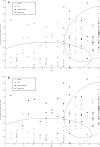Predicting knee osteoarthritis risk in injured populations
- PMID: 28618311
- PMCID: PMC5544598
- DOI: 10.1016/j.clinbiomech.2017.06.001
Predicting knee osteoarthritis risk in injured populations
Abstract
Background: Individuals who suffered a lower limb injury have an increased risk of developing knee osteoarthritis. Early diagnosis of osteoarthritis and the ability to track its progression is challenging. This study aimed to explore links between self-reported knee osteoarthritis outcome scores and biomechanical gait parameters, whether self-reported outcome scores could predict gait abnormalities characteristic of knee osteoarthritis in injured populations and, whether scores and biomechanical outcomes were related to osteoarthritis severity via Spearman's correlation coefficient.
Methods: A cross-sectional study was conducted with asymptomatic participants, participants with lower-limb injury and those with medial knee osteoarthritis. Spearman rank determined relationships between knee injury and outcome scores and hip and knee kinetic/kinematic gait parameters. K-Nearest Neighbour algorithm was used to determine which of the evaluated parameters created the strongest classifier model.
Findings: Differences in outcome scores were evident between groups, with knee quality of life correlated to first and second peak external knee adduction moment (0.47, 0.55). Combining hip and knee kinetics with quality of life outcome produced the strongest classifier (1.00) with the least prediction error (0.02), enabling classification of injured subjects gait as characteristic of either asymptomatic or knee osteoarthritis subjects. When correlating outcome scores and biomechanical outcomes with osteoarthritis severity only maximum external hip and knee abduction moment (0.62, 0.62) in addition to first peak hip adduction moment (0.47) displayed significant correlations.
Interpretation: The use of predictive models could enable clinicians to identify individuals at risk of knee osteoarthritis and be a cost-effective method for osteoarthritis screening.
Keywords: Gait; Injury; K-Nearest Neighbour; Knee; Osteoarthritis.
Copyright © 2017. Published by Elsevier Ltd.
Figures


References
-
- Andriacchi T.P., Mundermann A. The role of ambulatory mechanics in the initiation and progression of knee osteoarthritis. Curr. Opin. Rheumatol. 2006;18:514–518. - PubMed
-
- Astephen J.L., Deluzio K.J., Caldwell G.E., Dunbar M.J. Biomechanical changes at the hip, knee, and ankle joints during gait are associated with knee osteoarthritis severity. J. Orthop. Res. 2008;26:332–341. - PubMed
-
- Beattie K.A., Boulos P., Pui M., O'Neil J., Inglis D., Webber C.E. Abnormalities identified in the knees of asymptomatic volunteers using peripheral magnetic resonance imagining. Osteoarthr. Cartil. 2005;13:181–186. - PubMed
-
- Begg R., Palaniswami M. Idea Group; America: 2006. Computational Intelligence for Movement Sciences: Neural Networks and Other Emerging Techniques; p. 53.
-
- Bekkers J.E.J., deWindt T.S., Raijmakers N.J.H., Dhert W.J.A., Saris D.B.F. Validation of the knee injury and osteoarthritis outcome score (KOOS) for the treatment of focal cartilage lesions. Osteoarthr. Cartil. 2009;17:1434–1439. - PubMed
MeSH terms
Grants and funding
LinkOut - more resources
Full Text Sources
Other Literature Sources
Medical

